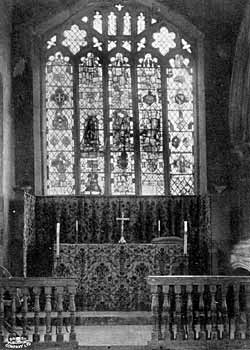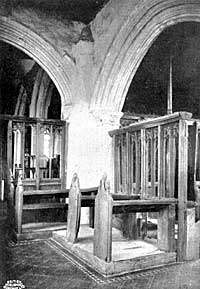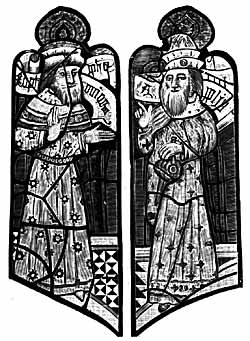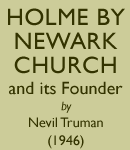THE FOUNDER'S TOMB
John Barton built his tomb during his life-time—a common practice in days when executors did not always do what they were told. The faces are not stereotyped shop-made articles, but look like portraits if you note the firm character in the Founder's face—just such as one would expect in a wealthy business man. Note the grim corners of the mouth. He wears a cassock-gown with a plain waist belt from which hangs his purse-pocket, decorated with five balls or tassels. There are also battered remains of his rosary (which his will tells us was of coral 'as he was wont to use). At his feet is his rebus —a barrel or tun with a bar across it for 'Barton'.
His wife Isabella wears a high-waisted dress, full skirt and tight bodice with a low-cut circular neck-opening with a wide border. The neck is covered with gauze save for an open V at the throat. Her belt is trimmed with squares and has a beautiful tongue adorned with Gothic leaves. Her headdress is a modified form of the 'Butterfly'. This was a gauze veil hung over wires worn over a white linen skull cap or coif. At her feet is her pet dog. Her whole costume is slightly old- fashioned.
Below them is a corpse as a 'memento mori' of what all must come to. On the Lady Chapel side is the touching inscription from Job xix, 21, in Latin: 'Miseremini mei saltem vos amici mei quia manus domini tetigit me' ('Pity me you at least my friends for the hand of the Lord has touched me').
Six blank shields at the base were supplied with painted heraldry copied from the Barton shields on the porch and other decoration on traditional lines was added in 1936.
THE GLASS (QUIRE)

High Altar and East Window.
The church now contains one of the finest collections of mediaeval glass in the county, but before its reconstruction it was in a deplorable state. Where it had fallen out it was patched with sheet glass cemented over the holes or stopped with putty; the glass had been leaded up so ignorantly that much was upside-down and inside-out; parts of the same design were separated in different windows; the tracery lights of the chancel window were partly bricked up, partly filled with plain nineteenth-century glass of crude and violent colour; great masses of the glass were completely obscured by thick deposits of dirt, and the leading was so weak that the glass yielded to the touch and a gale would have blown it out. Small panels of fragments were leaded up, without any regard to the design, in three windows of the chancel.
The reconstruction of 1933 cleaned and brought the fragments together in their proper places and filled the central three lights. Thus inscriptions run along the bottom witn little portraits of the donors and their families. Above these are three coats of arms. The shields, left to right, are (1) Barton and Bingham. (2) Barton, (3) Barton, Ratcliffe, Lee and Ashton.
Three large figures of saints occupy the greater portion of the lights with canopies above.
The centre figure is a bishop in gold and silver; that on the left a priest in a red and gold chasuble; that on the right a figure in a white alb.
The groundwork is full of diamond-shaped quarries with the Founder's merchant's mark, his initials, J.B., and his rebus, a 'bar' and 'tun'. The modern inscription reproduces the original one, as gathered from existing remains. It reads—
'Pray for the soul of John Barton of Holme, merchant of tlie Staple of Calais, Builder of this church, who died 1491, and for Isabella his wife. The fragments of his glass in the three centre lights were reconstructed by Nevil Truman of Nottingham 1933.'
The outer lights which had no painted glass, were filled with fourteenth-century glass formerly in Annesley ruined church. The four fine quatrefoils and other pieces had actually been left behind when the church was abandoned Seeing that they would soon be lost the author offered to transfer them to Holme, and Colonel Chaworth-Musters (in whose Park is Annesley Old Church) gladly consented and generously gave for the same purpose a box of pieces of the same date which he had found in one of his outbuildings and which also came from the church. This is recorded on a new inscription in the window. It is a matter for thankfulness that this fine old glass has thus been preserved from inevitable loss.
The lower two quatrefoils form a fine 'Coronation of our Lady'. Our Lord on the right with orb in hand, raises his right hand in blessing for his Mother who is on the left, crowned and wearing—not her traditional blue—but gold and brown robes.
The upper quatrefoils bear on the right the arms of Annesley and on the left those of Leigh. The shields are copies of the originals retained by Colonel Chaworth-Musters. All four quatrefoils have been skilfully made up from different portions of similar designs from various parts of the Annesley glass.
At the foot of the right outer light are some quarries with trailing oak leaves and acorns, and their fourteenth-century style can be contrasted with the fifteenth-century quarries elsewhere. The earlier pattern continues over more than one quarry; the later is confined to single quarries.
The traceries show censing angels in the outer lights of the top four and Tudor roses in the smaller lights. The large sexfoils and two inner lights at the top have been filled with quarries from the nave in place of the bad nineteenth century glass already mentioned.
Thus the whole window is filled with beautiful silvery old glass where previously it had only two small panels of badly arranged glass and a few tracery lights.
The reconstruction scheme for the three centre main lights was worked out by the author and Messrs. George and Dennis King of Norwich, who were the craftsmen. The reconstruction of the outer main lights and the traceries was worked out by the author, Mr. H. T. Hincks of Nottingham being the craftsman.
THE LADY CHAPEL
The brackets for the former roof have angels standing on clouds and bearing shields with the Calais Staple Arms and the Barton Merchant's Mark. Note the devil at the east end and the cherub at the west end. They were coloured and gilded in 1934.
When the Bartons came from Lancashire to Holme they brought a reredos from the Chapel of Smethehilles, Lancs., and set it up in the Lady Chapel. When the Founder's grandson died he ordered an alabaster reredos to be bought for Holme so that the borrowed one might be returned to its rightful place. Alas, both have gone. He also left money for the repair and necessary ornaments of Holme Lady Chapel.
Stone Altar. The mediaeval stone altar is 6in. thick and in one solid block still bearing the five crosses cut in it when the bishop consecrated it. They symbolize the Five Wounds of Christ. This altar was pulled down during the Reformation troubles and laid in the floor of the nave for anyone to trample on, the Reformers doing this in order to depreciate the Blessed Sacrament. About 1900 belated reverence was shown by laying it under the high altar, but it was there hidden from sight under a heavy wooden platform. At the Centenary of the Anglo-Catholic Revival it was again set up under the Chancellor's Faculty and after 400 years' neglect the Eucharist is again sung at it as in John Barton's day. The brass candlesticks are 1650-60.

Niches. The canopy and statute on the left of the altar were found some years ago when widening the road outside the church. They were returned to the place from which they had been cast out, but were left on the floor at the mercy of passing feet. In 1933 they were restored to their proper places. The companion figure is lost but the pair doubtless represented the Annunciation. St. Gabriel has gone but Our Lady remains. Notice under the latter statue the small deacon in a dalmatic, holding the chalice he is commissioned to administer when he is ordained. The lovely coloured image of Our Lady on the side wall is a copy of a fourteenth-century one in the Louvre.
Piscina. On the right of the altar is a fine piscina for receiving the water used by the priest when he washes his hands before the consecration at Mass. It was once also used for the ablutions until the priest was ordered to consume these. A Tudor rose conceals the drain holes between its petals and the ogee crocketed arch is beautiful.
Grave Slab. In the floor beneath is the grave slab of John Bellasis, a descendant of the last of the Bartons. Married in November 1716, he died the following April, one month after his wife. After but four months of married life their lines came to an end and the Barton estates passed to the Earl of Fauconberg who, about 1780, sold them to the Duke of Newcastle.
The familiar 'Requiescant in Pace', which is on the slab, shows that prayer for the dead has never died out in the English Church even in the reign of George I.
Stalls. Much panelling was lost and has now been restored, as have the carvings upon the fronts. These had been removed and badly fixed into the rood screen where they did not fit.
The furnishings of the chapel have remained unchanged since it was built by John Barton, and it was here that he would sit day by day for Mass and Evensong, where he could see the tomb he would himself occupy some day.
The poppy heads are full of character, especially fine being the middle one on the north side with oak leaves and eagles. Others have winged angels, dogs, lions and lionesses. On a southern side stall a dog barks at an animal in the foliage! Next to this is a chameleon, or perhaps the deaf adder in the Psalm, which stops its ears lest it hear the voice of the charmer, i.e., God.

Lady Chapel screens.
Screens. The screen in the eastern side-arch is lost, but the other remains, as does that between the Lady Chapel and the nave. Half the door had gone and has been renewed, but the remainder has still its fifteenth-century lock and sliding bolt. The white mark on the west side panels shows where until 1933 a vast Victorian pulpit was built on to it, obscuring and damaging it.
All the base panels of the side screen had disappeared, but have been renewed.
THE GLASS (LADY CHAPEL)

Lady Chapel. Two Prophets.
The traceries of the east window are filled with three interesting fifteenth-century Prophets and some fragments of a fourth.
Originally there was a prophet in each of the twelve tracery lights in the chapel windows. Those which remained were in a terrible state: holes had been roughly filled with putty or covered with slabs of clear glass. Dirt so obscured them that it was only on cleaning them that all the names were discovered. They have been reconstructed. From left to right they are (1) Fragments, (2) Sophonias, (3) Amos, (4) Isaiah. They wear flowered robes, ermine-edged capes and quaint turban-like hats. The colour scheme is entirely white and gold with alternate backgrounds of red and blue and they stand on tiled floors which are in every case differently patterned. There is a set of prophets in the windows of Fairford Church which was built by John Tame, another wool merchant, at the same time as Holme. Quite possibly Barton u ed to meet Tame and the two adopted the same idea for their windows. The arms are those of the Staple and (new) the Province of York. The main lights contain sixteenth and seventeenth-century pieces bought in Beauvais, some thirteenth-century fragments from Salisbury and (in the outer lights) a good 1856 copy of twelfth-century grizaille.
THE ODD PEW
One bench, at the east end of the south aisle, is different from the rest. It has a square end instead of a poppy-head, and is carved with fine Gothic window tracery. It may have been a Barton family pew, though they were more likely to sit in their own chantry Lady Chapel.
